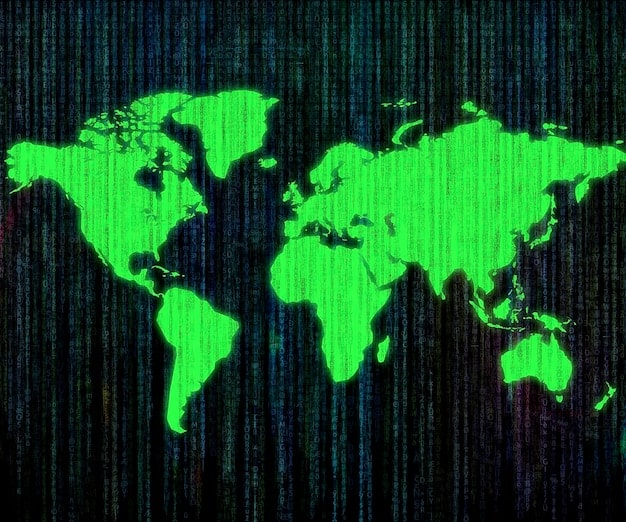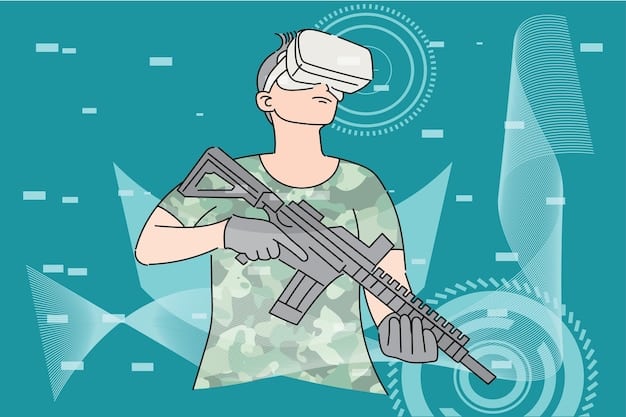Key Findings: Defense Intelligence Agency Report on Global Security Threats

The latest Defense Intelligence Agency (DIA) report highlights increasing global security threats, focusing on challenges posed by China and Russia, advancements in weapons technology, and the growing instability fueled by regional conflicts and climate change.
Understanding the key findings of the latest Defense Intelligence Agency (DIA) report on global security threats is crucial for policymakers, military strategists, and anyone concerned about international stability. This report offers a comprehensive overview of the challenges shaping our world.
Decoding the Global Security Landscape: An Overview
The Defense Intelligence Agency’s (DIA) latest report serves as a vital tool for understanding the multifaceted nature of global security threats. It provides insights into emerging risks, technological advancements, and geopolitical shifts that impact the United States and its allies.
The report delves into various domains, from conventional military threats to cyber warfare and economic espionage, offering a holistic assessment of the challenges facing the international community.

Rising Challenges from China and Russia
A significant portion of the DIA report focuses on the challenges posed by China and Russia. These nations are actively modernizing their militaries, expanding their global influence, and employing hybrid warfare tactics.
Understanding their strategic objectives and capabilities is paramount for maintaining a competitive edge and deterring aggression.
China’s Military Modernization
China’s rapid military modernization is transforming the balance of power in the Indo-Pacific region. The People’s Liberation Army (PLA) is investing heavily in advanced weapons systems, including naval power, hypersonic missiles, and artificial intelligence.
This modernization effort aims to project power beyond China’s borders and challenge the United States’ military dominance.
Russia’s Assertiveness and Hybrid Warfare
Russia continues to assert its influence through military interventions, disinformation campaigns, and cyberattacks. Its hybrid warfare tactics blur the lines between peace and conflict, creating instability and undermining international norms.
Russia’s actions in Ukraine, Syria, and cyberspace demonstrate its willingness to challenge the existing world order.
- Military Buildup: Both China and Russia are investing heavily in modernizing their armed forces, posing challenges to the United States’ military superiority.
- Technological Advancement: These nations are rapidly developing advanced weapons systems, including hypersonic missiles and cyber warfare capabilities.
- Geopolitical Influence: China and Russia are expanding their global influence through economic initiatives, military partnerships, and diplomatic efforts.
In conclusion, The DIA report underscores the growing challenges posed by China and Russia, emphasizing the need for strategic adaptation and enhanced deterrence.
Technological Advancements and the Future of Warfare
The DIA report emphasizes the transformative impact of technological advancements on the future of warfare. Emerging technologies such as artificial intelligence, autonomous systems, and biotechnology are reshaping the battlefield and creating new security dilemmas.
Staying ahead in the technological race is critical for maintaining a strategic advantage and safeguarding national security.
Artificial Intelligence (AI) and Autonomous Systems
AI and autonomous systems have the potential to revolutionize military operations, from intelligence gathering and analysis to autonomous weapons and logistics. However, the ethical and strategic implications of these technologies must be carefully considered.
The use of AI in warfare raises questions about accountability, bias, and the potential for unintended consequences.
Cyber Warfare and Information Operations
Cyber warfare and information operations are becoming increasingly prevalent in modern conflicts. State-sponsored actors are using cyberattacks to disrupt critical infrastructure, steal sensitive information, and spread disinformation.
Defending against cyber threats and ensuring the integrity of information are essential for maintaining national security.

The DIA report highlights that technological advancements are transforming the nature of warfare, creating new opportunities and challenges for the United States and its adversaries. Adapting to these changes requires investment in research and development, as well as the development of appropriate policies and regulations.
Regional Conflicts and Instability
The DIA report identifies regional conflicts and instability as significant sources of global security threats. Protracted conflicts, state failure, and humanitarian crises can create power vacuums, fuel extremism, and destabilize entire regions.
Addressing these challenges requires a comprehensive approach that combines diplomacy, development assistance, and security cooperation.
The Middle East
The Middle East remains a volatile region, plagued by sectarian conflicts, terrorism, and geopolitical rivalries. The rise of extremist groups such as ISIS and al-Qaeda, as well as the ongoing conflicts in Syria, Yemen, and Libya, continue to pose serious security challenges.
Addressing these challenges requires a multifaceted approach that addresses the root causes of conflict, promotes inclusive governance, and strengthens regional security cooperation.
Africa
Africa faces a range of security challenges, including terrorism, political instability, and resource competition. The spread of extremist groups in the Sahel region, as well as the ongoing conflicts in the Democratic Republic of Congo and South Sudan, are undermining stability and hindering development.
- Terrorism: Extremist groups such as ISIS and al-Qaeda continue to pose a threat to regional and global security.
- State Failure: Weak governance, corruption, and lack of economic opportunity can lead to state failure and instability.
- Humanitarian Crises: Conflicts and natural disasters can create humanitarian crises, displacing populations and disrupting essential services.
The DIA report underscores that regional conflicts and instability remain major sources of global security threats, requiring sustained attention and concerted efforts to promote peace, stability, and development.
Climate Change and Resource Scarcity
The DIA report recognizes climate change and resource scarcity as emerging security threats. Climate change can exacerbate existing vulnerabilities, such as water scarcity, food insecurity, and displacement, leading to social unrest and conflict.
Addressing these challenges requires a coordinated effort to reduce greenhouse gas emissions, adapt to the impacts of climate change, and promote sustainable resource management.
Impact of Climate Change on Security
Climate change can act as a “threat multiplier,” exacerbating existing tensions and creating new security risks. Rising sea levels, extreme weather events, and prolonged droughts can displace populations, disrupt economic activity, and undermine social stability.
These impacts can strain resources, intensify competition over scarce resources, and increase the risk of conflict.
Resource Scarcity and Conflict
Competition over scarce resources, such as water, land, and minerals, can lead to conflict and instability. As populations grow and demand for resources increases, the potential for conflict over these resources also rises.
Promoting sustainable resource management and equitable access to resources is essential for preventing conflict and promoting stability.
The DIA report emphasizes the role of climate change and resource scarcity as emerging security threats, highlighting the need for proactive measures to mitigate these risks and promote resilience.
Economic Security and Supply Chain Vulnerabilities
The DIA report also addresses economic security and supply chain vulnerabilities. Economic competition, trade disputes, and disruptions to critical supply chains can undermine national security and economic stability.
Diversifying supply chains, strengthening domestic industries, and protecting intellectual property are essential for maintaining economic security.
Economic Espionage and Cyber Threats
Economic espionage and cyber threats pose a significant risk to U.S. businesses and critical infrastructure. State-sponsored actors are engaging in cyberattacks to steal trade secrets, disrupt business operations, and gain a competitive advantage.
Protecting against these threats requires enhanced cybersecurity measures, intelligence sharing, and law enforcement cooperation.
Supply Chain Resilience
The COVID-19 pandemic exposed the fragility of global supply chains, highlighting the need for greater resilience and diversification. Disruptions to critical supply chains can have cascading effects, impacting industries ranging from healthcare to manufacturing.
Strengthening supply chain resilience requires diversifying sources of supply, investing in domestic industries, and promoting regional cooperation.
The DIA report underscores the importance of economic security and supply chain resilience, emphasizing the need for proactive measures to protect U.S. businesses and critical infrastructure.
Strategic Recommendations and Policy Implications
The DIA report concludes with strategic recommendations and policy implications for addressing the identified global security threats. These recommendations call for enhanced intelligence gathering, strategic partnerships, and investments in defense capabilities.
Implementing these recommendations will be critical for maintaining a competitive edge and safeguarding U.S. national interests.
Enhancing Intelligence Gathering and Analysis
Effective intelligence gathering and analysis are essential for understanding the evolving threat landscape and anticipating future challenges. Investing in human intelligence, cyber intelligence, and open-source intelligence can provide policymakers with timely and accurate information.
Improving intelligence sharing with allies and partners is also critical for enhancing situational awareness and coordinating responses to security threats.
Developing Strategic Partnerships
Strategic partnerships are essential for addressing global security threats that transcend national borders. Collaborating with allies and partners can leverage complementary capabilities, share burdens, and enhance collective security.
Strengthening existing alliances and forging new partnerships with like-minded nations can enhance deterrence and promote stability.
Investing in Defense Capabilities
Maintaining a strong and modern military is essential for deterring aggression and protecting U.S. national interests. Investing in advanced weapons systems, cyber capabilities, and space-based assets can ensure that the United States remains a dominant military power.
Modernizing the military and adapting to emerging technologies are critical for maintaining a competitive edge in the 21st century.
In conclusion, the DIA report offers valuable insights into the evolving global security landscape and provides strategic recommendations for addressing the identified threats. Implementing these recommendations will require sustained attention, investment, and cooperation among government agencies, allies, and partners.
| Key Point | Brief Description |
|---|---|
| 🛡️ China & Russia | Military modernization and assertive foreign policy. |
| 🚀 Tech Advances | AI, cyber warfare, and autonomous systems transformation. |
| 🌍 Regional Conflicts | Instability in the Middle East and Africa impacts global security. |
| 🌡️ Climate Change | Exacerbates resource scarcity and security risks. |
Frequently Asked Questions
▼
The report primarily focuses on emerging and evolving global security threats, analyzing the capabilities and intentions of various state and non-state actors that pose risks to the United States and its allies.
▼
The report highlights China’s rapid military modernization, its expanding global influence, and its use of hybrid warfare tactics as key areas of concern, emphasizing the need for strategic competition.
▼
The report emphasizes that cyber warfare and information operations are becoming increasingly prevalent, with state-sponsored actors using cyberattacks to disrupt infrastructure and spread disinformation.
▼
The report recognizes climate change as a ‘threat multiplier’ that exacerbates existing vulnerabilities such as resource scarcity, leading to social unrest and increased risk of conflict globally.
▼
Key recommendations include enhancing intelligence gathering and analysis, developing strategic partnerships with allies, and investing in modern defense capabilities to maintain a competitive edge and safeguard national interests.
Conclusion
In summary, the Defense Intelligence Agency’s latest report paints a complex picture of the global security environment, identifying key threats ranging from traditional military challenges posed by nations like China and Russia to emerging risks such as cyber warfare, climate change, and economic vulnerabilities. Understanding these findings is crucial for developing effective strategies to protect U.S. interests and promote international stability.





